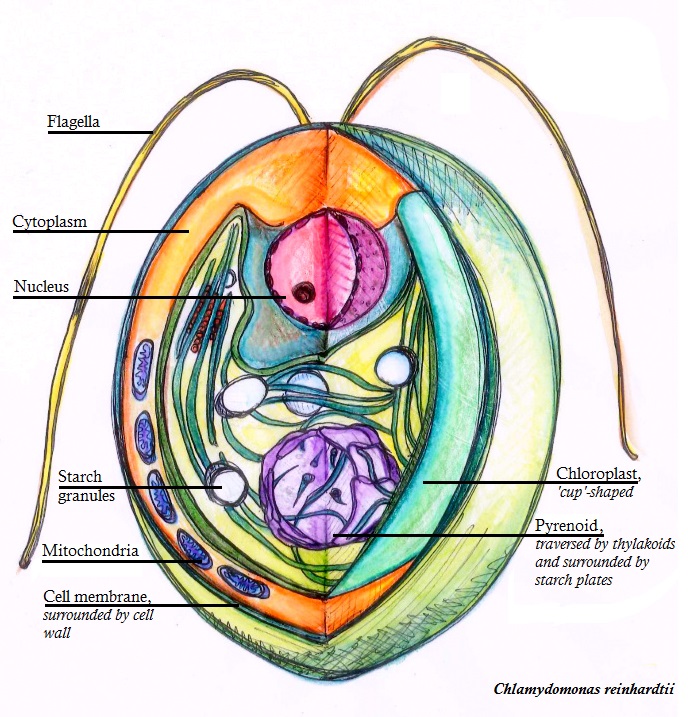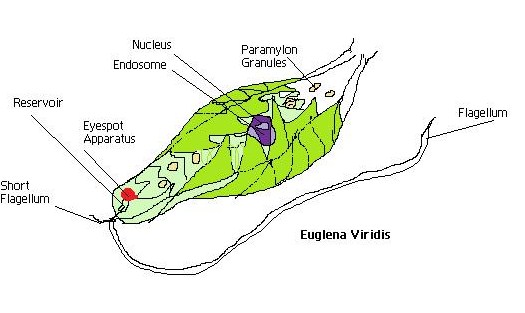Cell of different organisms exist in different forms. Some are single and free living, others may be colonial, filamentous or part of a living organisms
Cell as independent or single or free living organisms. Cell may live as independent organisms capable of living freely on their own. Such organism even though it has only one cell is able to carry out life processes such as Movement, Reproductions, Sensitivity, Excretion, Growth e.t.c. Example of such organisms are Amoeba, Paramecium, Euglena, Chlamydomonas.

The Chlamydomonas is oral or spherical in shape and is bounded by cell wall consisting of hemi-cellulose. At the anterior end, the wall projects and thickens into a colourless papilla. Two flagella which arise from the anterior end are used fo rmovement. Chose to the base of the flagella are two contractile vacuoles which are used for osmoregulation.
Within the cytoplasm is the nucleus and a cup shaped chloroplast which contains chlorophyll which the organism use for A pyrenoid responsible for the storage of starch occur within the chloroplast. An eye spot is embedded on one side of the cell close to the anterior end. The eye spot responds to light stimulus. Chlamydomonas is an organism that shares both the characteristics of plants and animals. The animal characteristics include flagella for locomotion, eye sport responds to light source, contractile vacuole for osmoregulation. The presence of chloroplast containing chlorophyll for photosynthesis and storage excess carbohydrate as starch are plant characteristic chlamydomonas.

The organism is a single celled, naked colourless, microscopic about 0.07mm, shapeless and jelly-like animal. It is made up of cytoplasm and nucleus. The nucleus is divided into non-gramular liquid layer called ectoplasm and granular layer called endoplasm. The cytoplasm is bounded by a thin flexible cell membrane called plasma membrane which keep the cell content or plasmalema together. The ectoplasm forms pseudopodia (false feet) for movement and capturing of food. Exchange of gases (oxygen and carbon iv oxide) and ammonia occurs at the ectoplasm. The endoplasm is divided into an outer viscous portion called plasmagel and an inner liquid portion called plasmasol. The plasmasol contain the following cytoplasmic structured.
Contractile Vacuole: It excretes liquid product such as dissolved ammonia and regulates amount of water and mineral salt that enter and leave the cell (osmoregulation).
Food Vacuole: It is used for storage and digestion of food
Nucleus contains chromosome which are hereditary unit.

The organism is slipper shaped with a length ranging 0.15 to 0.30mm. the anterior part is blunt or rounder while the posterior part is pointed. Paramecium Caudatum is divided into two distinct parts, the ectoplasm and the endoplasm. The thin layer of ectoplasm is bounded outside by a clear and elastic membrane called pellicle which make the animal having a definite slipper shape. The entire pellicle is covered fine cilia used for locomotion, embedded in the ectoplasm are spindle shaped bodies called trichoicyst which contains filaments that can be discharged either to trap a prey and hold it or used for offense and defence.
The endoplasm is granular, large and contains the following organells anterior and posterior contractile vacuoles, food vacuoles which are formed near the gullet (cytopharynx. There are two nuclear- meganucleus and micronucleus which are centrally phased in the endoplasm. The maganucleus is bean shaped or kidney shaped. It controls the ordinary activities of the cell.
The two contractile vacuoles are used to remove excess water from the animal.
At one side of P. caudatum is a depression called oral groove which lead to a gullet through which food particle can be swallowed. At the posterior and is a small opening anal pore through which indigested food material is ejected from the body.

Euglena is a pear or spindle shaped single celled organism. It is about 0.66mm in length with the widest width at the middle of the body. The anterior part is blunt or rounded while the posterior part is pointed. The body is divided into clear ectoplasm and granular endoplasm. The organism lives in water. It is a boarder line between plant and animal
The ectoplasm (plasmagel) is bonded by a thin, flexible, tough and elastic covering called pellicle which enable the animal to carry out a type of locomotion called euglenoid movement. Within the cytoplasm are rod-shaped structures called chloroplast which contain chlorophyll hence Euglena is green in colour and is able to carry out photosynthesis.
The granular endoplasm (plasmasol) contains myonemes ( thin fibres) and paramylum granules containing starch reserve. The nucleus is bounded by a nuclear membrane which contain the nucleolus and nucleolus. At the anterior part of the organism is a flask-shaped opening called gullet. Below the gullet is a granule called blepharoblast. Arising from the blapharoblast a rhizoplast arising the blepharoblast is rhizoplast believe to initiate cell division. From the flagellum used for locomotion, at the base of the gullet lies a large contractile vacuole used for osmoregulation. There is presence of eye spot which respond to light stimulus
Euglena has a mixture of plant food and animal characteristics
Euglena as a plant
(i)The presence of chloroplast which is used for photosynthesis
(ii)Stores excess carbohydrate as starch called paramylum granules only plant stores starch
(iii)Definite shape (pellicle)
Euglena as an animal
(i)Possession of eye spot which sensitive to light. It is not used for sight
(ii)Possession of flagellum for locomotion
(iii)It carries out holozoic feeding in the absence of sun light by using the gullet to ingest foodparticles
(iv)Contractile vacuole for osmoregulation
(v)No cellulose cell wall but flexible living pellicle
(vi)No central cell sap vacuole is small and not central
Certain organism are composed or numerous and similar cells joined by strand of protoplasm. Each associating cell has nucleus,cytoplasm and a pair of flagella. The flagella enable the colony to swim by rolling over and over. The cells making up the colony are not differentiated into tissues e.g. Eudorina pandorina and volvox

Some independent cells arranged themselves into filament. The filament of spirogyra consists of
about twelve cylindrical cells all similar in size bound together by a cell wall and mucilage, each cell is separated from the other by intercellular cell walls. Each cell can live independently and is capable of carrying out asexual reproduction to form a new filament.
Spirogyra is an unbranched green filamentous alga consisting of a chain of cylindrical cells. The entire filament is covered with a layer of mucilage which makes it slimy. Inside each cell is a lining central vacuole. In the cytoplasm the chloroplasts are arranged spirally. Each chloroplast contains pyrenoids. The nucleus is suspended by cytoplasmic threads.

Most multicellular organisms are made up of groups of cells which are similar in shape and structure. The cell making in shape and structure. The cells making up the group work together for a particular function. The specialized group of cells is called tissue. Each cell depends on the other for efficient performance.
Questions (Post question title and answer in the comment box below for evaluation and discussion)
(a)What is a cell?
(b)Outline the cell theory as propounded by the following biologist
Robert Hook, Dujardin, Schleiden Mathias and Theordor Schwann
(c)Make a diagram 8 10 cm long of chlamydomonas and label the diagram full
(d)State (i) two advantages and
(ii) Two disadvantages of a unicellular organisms has over a multicellular organisms
Read our disclaimer.
AD: Take Free online baptism course: Preachi.com 